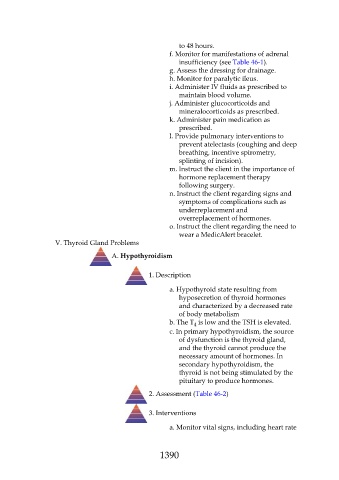Page 1390 - Saunders Comprehensive Review For NCLEX-RN
P. 1390
to 48 hours.
f. Monitor for manifestations of adrenal
insufficiency (see Table 46-1).
g. Assess the dressing for drainage.
h. Monitor for paralytic ileus.
i. Administer IV fluids as prescribed to
maintain blood volume.
j. Administer glucocorticoids and
mineralocorticoids as prescribed.
k. Administer pain medication as
prescribed.
l. Provide pulmonary interventions to
prevent atelectasis (coughing and deep
breathing, incentive spirometry,
splinting of incision).
m. Instruct the client in the importance of
hormone replacement therapy
following surgery.
n. Instruct the client regarding signs and
symptoms of complications such as
underreplacement and
overreplacement of hormones.
o. Instruct the client regarding the need to
wear a MedicAlert bracelet.
V. Thyroid Gland Problems
A. Hypothyroidism
1. Description
a. Hypothyroid state resulting from
hyposecretion of thyroid hormones
and characterized by a decreased rate
of body metabolism
b. The T is low and the TSH is elevated.
4
c. In primary hypothyroidism, the source
of dysfunction is the thyroid gland,
and the thyroid cannot produce the
necessary amount of hormones. In
secondary hypothyroidism, the
thyroid is not being stimulated by the
pituitary to produce hormones.
2. Assessment (Table 46-2)
3. Interventions
a. Monitor vital signs, including heart rate
1390

